#post von wagner
Text
three dorks
#more useless content#i always feel so bad when i post this stuff i'm sorry#claus von wagner#heute show#it should be a cool episode if till and gisa are there too!#cvw
9 notes
·
View notes
Text
i bring you a dashboard siren to draw visitors to your blog!

ok really just an excuse to post this siren whose background i painstakingly removed for no reason in particular, no magical powers included. I just really enjoy this painting on a bowl and isolating it was relaxing to do. I also only really saw just how odd her feet were while i was trying to get the fuzzy select tool to pick up on the shape of her claws.
source: Bowl with winged siren, Apulia, 330-310 BC, H 5751 - Martin von Wagner Museum - Würzburg, Germany
#i love when sirens have big bird claws and then pretty normal outfits. great combination. also i need to find other ways to relax#siren#ceramics#apulia#ancient art
582 notes
·
View notes
Text




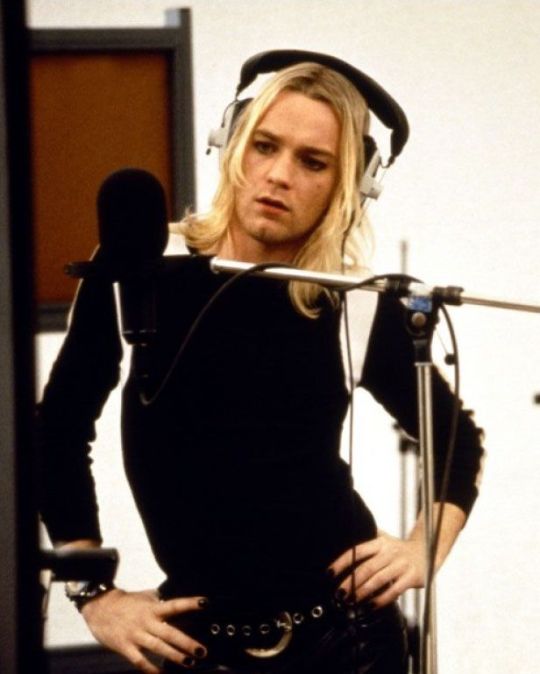
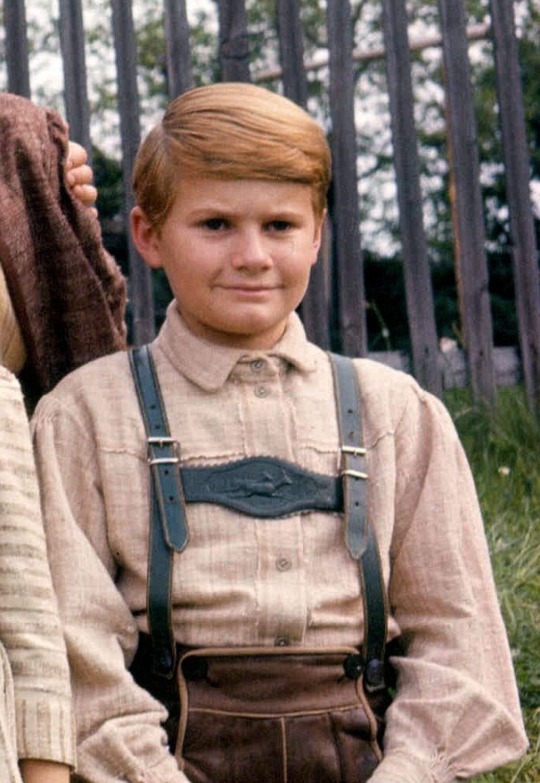
I'm doing a series of "Best Character Named X" polls where all the characters have the same first name but are from completely different media, feel free to send in name/charcacter suggestions, I'm posting one poll a day, check my pinned post for active polls
#best character named x#poll#poll game#kurt wagner#nightcrawler#kurt hummel#curt mega#curt connors#lizard#curt wild#kurt von trapp#x men#glee#spies are forever#spider man#velvet goldmine#sound of music
85 notes
·
View notes
Text
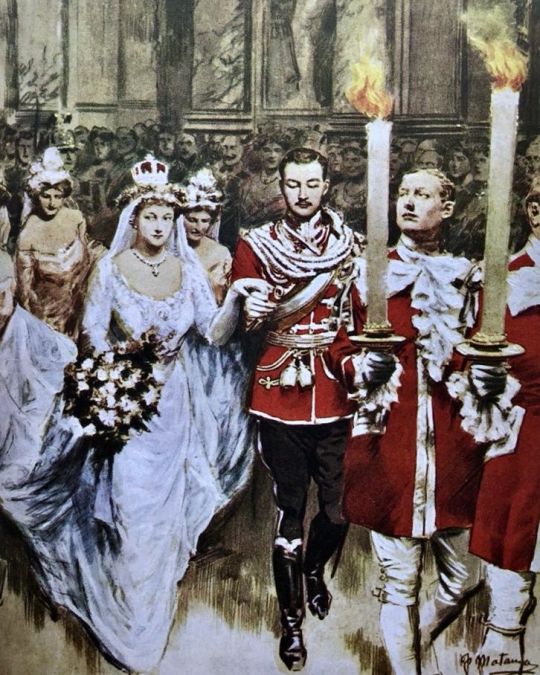
The 20th of May was my last day in the New Palace, and on the 21st Ernst August arrived. In his last letter he had told me what arrangements he had made to keep our honeymoon location secret from prying eyes. It was planned that we should go first to the hunting lodge at Werbellinsee, then to the Hubertihaus, my father-in-law’s hunting lodge near Gmunden. He made me promise not to tell anyone at all and even in Gmunden itself our plans were kept strictly secret.
The first wedding guests to arrive were the King and Queen of England, and my parents went to the Lehrter Station in Berlin to greet them. George V had put on his Prussian General’s uniform for the occasion and, with an escort of Dragoon Guards and Cuirassiers, the Royal couple drove through Berlin. More than half a century was to pass before an English Head of State was to come to Germany again, when Queen Elizabeth II, George V’s grand-daughter, came in 1965.
Early on the following day my great-aunt Luise, Prince Max of Baden and his wife arrived, then a little later my parents-in-law and my sister-in-law, Olga. The First Guards Regiment of Foot formed the guard of honour, while the Cuirassiers again provided the escort as we travelled to the castle in three carriages. My father sat with the Duke, who wore his Austrian uniform, in the first carriage; my mother with the Duchess Thyra in the next, while Princess Olga, my fiancé and I sat together in the third.
At midday the Czar of Russia arrived and the colourful welcoming ceremonies began all over again. Wearing the uniform of the Alexander Grenadier Guards Regiment and the tall Frederick the Great cap on his head, Nicholas II’s truly imposing appearance drove the waiting Berliners into a frenzy of excitement and wonder... For me, the wedding celebrations began with the reception of deputations who had come bringing gifts. My father’s present to me was a diadem and a pearl necklace, while my mother gave me a diamond tiara. King George and Queen Mary gave me a prodigious gold goblet anda diamond brooch; Ernst August a complete jewellery outfit. The English Queen Mother, Alexandra, gave me an emerald brooch. From the Czar I received an aquamarine and diamond necklace; the Italian King and Queen sent me antique silver vessels and Queen Wilhelmina of Holland an antique pendulum clock. There were presents galore, from the Kings of Denmark and Sweden down to the various cities in Germany, and from Brunswick I received a diadem which had once belonged to the French Empress Josephine. The number of gifts was so great they required several furniture vans to carry them.
The real celebrations began on the evening of the day before the wedding, with a gala opera when the Royal Court Opera put on Richard Wagner’s Lohengrin. The Opera House, when I arrived, was bedecked with my favourite flowers, pink carnations, and as we took our places in the Royal Box with our parents, all those present rose from their seats, and Ernst August and I bowed right, left and centre. As one, the entire audience bowed back. Next day, 24 May, was my wedding day. Early in the afternoon my mother helped me on with my bridal crown and veil. Then we repaired to the Chinese Room, and we found that a unit of soldiers had formed lines throughout the castle and taken up sentry posts everywhere. There was a bodyguard from the rst Guards Regiment, the Castle Guard in their historic Frederick the Great uniforms, the Garde du Corps in ceremonial dress, and the gendarmerie. At 4 p.m. members of the staff of the Royal Privy Purse came by, carrying the bridal crown of the Princess of Prussia. Then the Mistress of the Empress’s Household, Therese, Countess von Brockdorff, picked up the crown and ceremoniously handed it to my mother who carefully placed it on my head. We then proceeded to the chamber deemed the ‘Elector’s Room’ where my father received us, and Count Eulenberg, the Minister for the Royal House, completed the formalities regarding the marriage pact and the official registration of the marriage. As Ernst August and I signed the register, we heard a loud buzzing overhead above the castle. We all rushed to the windows and there above us was the airship Hansa, all gaily decorated with colourful pennants. Suddenly, a large bouquet of flowers came floating down from the airship. It was their way of congratulating us.
After the civil ceremony, the bridal procession, led by the Corps of Pages, wound its way through the Picture Gallery and the White Hall to the castle chapel. Behind the pages walked two Heralds with the Brandenburg and Prussian Coat of Arms, then the Chief Marshal, Prince zu Fiirstenberg with his big Marshal’s staff, and finally Ernst August and me. Behind us were the Kaiser in the uniform of the 1st Guards Regiment, with the Duchess of Cumberland in a lilaccoloured gown, then the Generals and the Admirals, and then the Kaiserin in a light green robe escorted by the Duke of Cumberland in his Austrian uniform. Then the Czar of Russia, in his Hussar uniform, escorted the Queen of England. The King of England, in his Cuirassier uniform, escorted the Crown Princess. Then they were followed by a whole host of Princes, including my brothers, and Princesses, Dukes and Duchesses. It was 5 p.m. by the time we reached the chapel to be greeted by the sound of music from the organ.
Bright sunlight filtered through the chapel cupola as Ernst August and I stepped up to the altar which my mother and Crown Princess Cecilie, my sister-in-law, had decorated with roses, carnations and wreaths. Pastor Dryander then delivered his sermon, earnest and worthy words which warned me about the seriousness of life.
After that came the actual marriage ceremony. Ernst August’s ‘yes’ rang out so loudly and clearly that I had to follow suit and when we joined hands in front of the altar he clasped mine very firmly, insisting that his thumbs were on top of mine. You see, there’s an old folk-tale which says that if the husband does not have his thumbs above those of his bride at the wedding ceremony then he will have no say during his marriage. Pastor Dryander looked slightly shocked at this little demonstration, but Ernst August and I just smiled at each other. Mary, the Queen of England, however, was so overcome by the whole ceremony that she broke into a flood of tears. Later, they used to say that she had sobbed because she had at that moment foreseen the forthcoming disaster of war the following year breaking over us. That is really out of the question. Queen Mary was very attached to the Guelph family and it was understandable that the ceremony should affect her.
As soon as the vows and rings had been exchanged, the battery of the rst Guards Field Artillery Regiment fired a 36-gun salute, the chapel bells rang out in loud peals, and the wedding party made its way to the White Hall again, where we stood under the canopy of the Throne and received congratulations from the guests filing past, as the orchestra played the “Wedding March’ from Midsummer Ni ght’s Dream. My husband and I had my father standing to our ri ght together with my mother-in-law, Queen Mary and the Czar, and on our left my mother, my father-in-law, Crown Princess Cecilie and King George V.
The ceremonial banquet began at 7 p.m. and was attended by one thousand one hundred guests. The remarkable thing about it was that the food was dished up by Lieutenant-General Baron von Siisskind, the Inspector of the Militia, at one end of the table and by LieutenantGeneral von Falk, the Inspector of the War Academy, at the other. They served the food then passed the plates to the lackeys, who handed them to the Court officials, and so on to each guest. As soon as the dinner was over, the White Hall became the setting for the traditional torch-dance, a sort of polonaise which, in earlier times, was danced with senior Court officials carrying big, heavy candles ahead of the procession of dancers. For these elderly gentlemen then it was certainly no easy task, but in my time these duties were taken over by the pages, who were physically better equipped. My father gave the Chief Marshal orders for the torch-dance to begin. Prince zu Fiirstenberg came up to my husband and me, bowed, and invited us to lead the dance. The band of the Guards Cuirassiers struck up a polonaise, the Chief Marshal placed himself at the head of the procession of dancers and, with twelve pages lined up two by two behind him, signalled for Ernst August and me to lead off the dance.
The spectacle of my dancing with the King of England and the Czar of Russia absolutely fascinated everybody present. It wasn’t something that happened every day, of course, but there were the rulers of the two mightiest nations on Earth, with the daughter of the German Kaiser between them, all dancing together. At the end of the dance the Czar turned to me and said: ‘My wish is that you will be as happy as I am.’ I have never forgotten those words: they were the last I was ever to hear from Czar Nicholas. The torch-dance was over. I left the room on my father’s arm, while my husband escorted my mother. The Prussian Princess’s Crown was taken away from me and given back for safe keeping to the officials of the Privy Purse. Then my mother lifted off my bridal wreath. The hour of parting had struck. We changed our clothes and went to the station accompanied by my father and four of my brothers".
The Kaiser's daughter: Memoirs of H. R. H. Viktoria Luise, Duchess of Brunswick and Lüneburg, Princess of Prussia
youtube
13 notes
·
View notes
Text
Some dancers competing at two or more nationals
(will be added on to once other schedules have been posted)
this list only includes dancers that are attending at the least one nationals without the majority of their studio/as individuals
4PM Dance
Sarahi Lopez-Prieto (Junior) - LV & Radix
CSPAS
Stella Brinkerhoff (Mini) - TDA LV & Radix
Tabitha Nan (Junior) - TDA LV & Radix
Brooklyn Ward (Junior) - TDA LV & Radix
Halle Hunt (Teen) - TDA LV & Radix
Club Dance Studio
Mikayla Isler (Mini) - TDA LV & Radix
Dance Deluxe
Vanessa Soto (Teen) - Radix & KAR LV
Dance Town
Belle Marie Arauz (Mini) - TDA LV & NYCDA (?)
Amanda Carpenter (Mini) - TDA LV & NYCDA (?)
Victoria Remon (Mini) - TDA LV & NYCDA (?)
Zachary Roy (Teen) - TDA LV & NYCDA (?)
Elite Dance Pro
River Segerman (Junior) - TDA LV & Radix
JBP Entertainment
Georgia Beth Peters (Teen) - TDA LV & Radix
K2 Studios
Jessica Sutton (Mini) - TDA LV & KAR Anaheim
Kynzli Reece (Mini) - TDA LV & KAR Anaheim
Neriah Karmann (Mini) - TDA LV & KAR Anaheim
Abby Viramontes (Mini) - TDA LV & KAR Anaheim
Michelle Latimer Dance Academy
Alivya Neeriemer (Junior) - TDA LV & Radix
Ellie Brunson (Teen) - TDA LV & Radix
N10
Sloane Adams (Teen) - TDA LV & NYCDA Phoenix
Nor Cal Dance Arts
Mika Takase (Junior) -TDA LV & Radix
Pave School of The Arts
Liv Matson (Mini) - TDA LV & Radix
Addyson Paul (Junior) - TDA LV, Radix & KAR Anaheim
Tayah Klimuck (Junior) - TDA LV & Radix
Project 21
Aliya Yen (Mini) - TDA OR & NYCDA Phoenix
Cece Chung (Mini) - TDA & NYCDA Phoenix
Olivia Armstrong (Junior) - TDA OR & NYCDA Phoenix
Leilani Lawlor (Junior) - TDA OR & NYCDA Phoenix
Kira Lieberman (Junior) - TDA OR & NYCDA Phoenix
Brystyn Scifres (Junior) - TDA OR & NYCDA Phoenix
Berkely Scifres (Junior) - TDA OR & NYCDA Phoenix
Regan Gerena (Junior) - TDA OR & NYCDA Phoenix
Sara Von Rotz (Junior) - TDA OR & NYCDA Phoenix
Leighton Werner (Teen) - TDA OR & NYCDA Phoenix
Lilly Barajas (Teen) - TDA OR & NYCDA Phoenix
Brielle Lieberman (Teen) - TDA OR & NYCDA Phoenix
Brooklyn Ladia (Teen) - TDA OR & NYCDA Phoenix
Stella Eberts (Teen) - TDA OR & NYCDA Phoenix
Gracyn French (Teen) - TDA OR & NYCDA Phoenix
Sammi Chung (Senior) - TDA OR & NYCDA Phoenix
Stars Dance Studio
Ella Dobler (Junior) - TDA LV & Streetz
Summit Dance Shoppe
Audrey Dorsey (Junior) - Radix & Showbiz
Greta Wagner (Junior) - Radix & Showbiz
Aaliyah Dixon (Teen) - Radix & Showbiz
Leighton Curry (Teen) - Radix & Showbiz
The Academy at The Brea Space
Francesca Jen (Junior) - TDA LV & Radix
Kinsley Oykhman (Teen) - TDA LV & Radix
Allison Shin (Teen) - TDA LV & Radix
The Company Space
Piper Perusse (Junior) - TDA LV & Radix
The Rock Center For Dance
Melina Biltz (Mini) - TDA LV & Radix
Lily Whiddon (Mini) - TDA LV & Radix
Lola Farias (Junior) - TDA LV & Radix
Rissa Laguana (Junior) - TDA LV & Radix
Alexis Mayer (Teen) - TDA LV & Radix
Sophia Rudy (Teen) - TDA LV & Radix
The Vision Dance Alliance
Kennedy Anderson (Junior) - LV & Radix
Emily Polis (Junior) - TDA LV & Radix
Caitlyn Polis (Teen) - TDA LV & Radix
Yoko's Dance & Performing Arts Academy
Isabel Dela Cruz (Teen) - TDA LV & KAR Anaheim
15 notes
·
View notes
Text

Von Wagner rolls up Bodhi Hayward. An eye-catching image recently posted to WR's Screencaps blog.
#rollup pin#hook the leg#pinned male#man on display#leg tangle in pro wrestling#defeated man#male domination#black wrestling trunks
17 notes
·
View notes
Photo
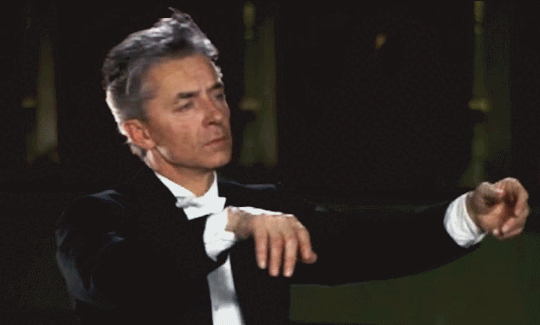
Those who have achieved all their aims probably set them too low.
- Herbert von Karajan
The Soprano Christa Ludwig described him as ‘Le bon Dieu’, while scores of musicians, reviewers and listeners have long regarded him as simply untouchable in the art of conducting. There was, however, much about Herbert von Karajan that was distinctly ungodlike. Ruthlessly ambitious as a young man and grimly autocratic in his later years, his life story is marked by bitter rivalries, feuds and, most notoriously, membership of the Nazi party.
But then, just listen to the results. It’s fascinating to look at the career, the controversy and the achievements of a conductor who still intrigues fans and detractors like no other musician long after his death.
The early career of Herbert von Karajan continues to be swathed in controversy.
Was he an ardent Nazi or an ambitious opportunist? If he was a zealous party member, should we revere his recordings as much as we do? To what extent should any moral accountability weigh against Karajan’s musical achievement? And how much latitude can we extend to people who have artistically given so generously?
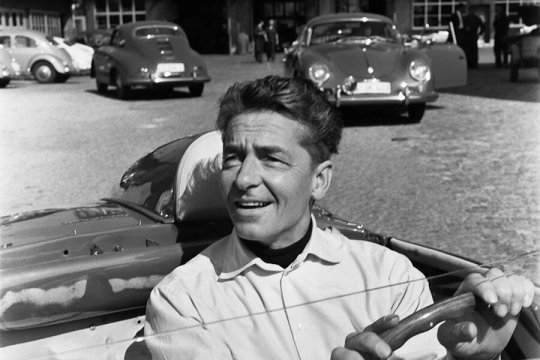
Karajan is not alone in occupying this uncomfortable situation during this era. Similar debate surrounds Richard Strauss, Carl Orff and Karl Böhm. Indeed, Wagner also evokes hostility in certain quarters with regard to his racial sentiments.
When Adolf Hitler swept to power in January 1933, the 24-year-old Austrian Herbert von Karajan had already notched up nearly four seasons as an up-and-coming opera conductor in the South German city of Ulm.
Born in Salzburg in 1908 into a prosperous family, he had demonstrated gifts as a pianist and conductor while studying in Vienna. After graduation, his debut orchestral concert with the Salzburg Mozarteum Orchestra in January 1929, featuring works by R Strauss, Mozart and Tchaikovsky, caused a local sensation and helped to secure him the contract in Ulm.
Karajan seized on the opportunity to learn his trade in Ulm and cut his teeth on much of the operatic repertory from Mozart and Beethoven to Puccini and R . Strauss, including the opera Schwanda der Dudelsacker by the Czech Jewish composer Jaromir Weinberger.
Yet, after the Nazi take-over, Karajan’s future wasn’t assured.
In early 1933, German operatic life was thrown into turmoil as the regime hounded out musicians that were deemed politically and racially unacceptable, and also pursued a protectionist policy to limit employment for non-Germans.
Against this context, Karajan’s decision to join the Nazi Party in Salzburg in April 1933 should be understood as an opportunistic move which was probably designed to safeguard his position at Ulm. Whether it also signalled enthusiasm for Nazi policy is open to speculation, though he no doubt hoped that the strong-arm methods of the Nazis would bring cultural stability to Germany.
Karajan retained his Ulm job for a further season, during which he expanded his repertory to include a praised account of Strauss’s opera Arabella. But in March 1934 he was fired for professional intrigue involving a potential Jewish rival.
He did not have to wait long for a new post. Three months later he was made general music director in Aachen.
Working in a larger theatre enabled Karajan to tackle more ambitious repertory, such as Wagner’s Ring cycle, Verdi’s Otello and Strauss’s Elektra. He also consolidated his reputation in the concert hall, taking charge of Aachen’s annual season of orchestral and choral concerts. One pre-condition for accepting was that he should re-apply for membership of the Nazi Party, his earlier membership in Salzburg having lapsed. This was confirmed in March 1935.

Although in his denazification trial in March 1946 Karajan argued that he had joined the Party to further his career, he could not escape his obligation as Aachen’s general music director to provide the musical background for political occasions.
On 29 June 1935 he took part in a huge open-air orchestral and choral concert that celebrated the NSDAP Party Day and at a similar ceremony four years later he conducted the close from Wagner’s Meistersinger. But his concert programmes seemed untainted by political interference – works by Debussy, Ravel, Kodály and Stravinsky rubbed shoulders with German ones. In 1938 he flouted the law by programming Dukas’s Sorcerer’s Apprentice. Party authorities must have overlooked that Dukas was of Jewish descent.
Karajan conducts Dvořák’s “New World” Symphony No. 9, performed by the Vienna Philharmonic Orchestra
By 1937 Karajan’s achievements in Aachen were attracting national interest.
In a special edition devoted to Germany’s conducting legacy, the journal Die Musik singled him out as a man who ‘can lead the new organisation of our cultural life in the spirit and direction which National Socialism demands’. Concert engagements in Gothenburg, Vienna, Amsterdam, Brussels and Stockholm helped to spread his name beyond Germany.
Yet for all this, Karajan set his sights even higher by hoping to make an impact in Berlin. This ambition was realised in 1938 with a ‘Strength through Joy’ concert with the Berlin Philharmonic and engagement as conductor at the Berlin State Opera in Wagner’s Tristan und Isolde in October of the same year.
Karajan may not have anticipated that with his move to Berlin he was stepping into a political cauldron over which he would have little control.
It began with a review of his Tristan which appeared in the Berliner Zeitung. Under the title ‘Karajan the Miracle’, the critic Edwin von der Nüll lavished praise on the performance suggesting that in conducting Wagner’s score from memory the 30-year-old conductor had achieved ‘something our great men in their fifties might envy’.
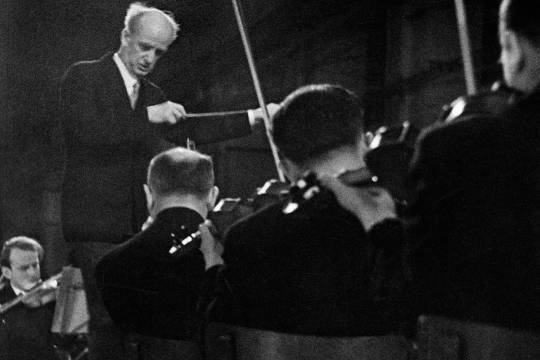
This was calculated to offend the conductor Wilhelm Furtwängler who had previously ruled the roost in the same theatre. Karajan was set up as a pawn in the struggle for control of Berlin’s cultural institutions between Propaganda Minister Joseph Goebbels, a Furtwängler supporter, and Minister of Interior Hermann Goering, the patron of the Berlin State Opera.
In June 1939 Karajan conducted Wagner’s Die Meistersinger at the State Opera without a score. The performance collapsed when the baritone, a drunk Rudolf Bockelmann, made a serious error. Alas Hitler, in the audience, was furious, blaming instead Karajan’s insufficiently Germanic approach to Wagner by conducting from memory.
Further problems arose over his marriage in 1942 to the quarter Jewish Anita Gütermann, technically against the law.
Yet, despite this and the continuing hostility and suspicion of Goebbels and Hitler and Furtwängler’s jealousy, his career prospered during the war. He conducted Bach’s B Minor Mass in Paris for the occupying German soldiers in 1940 and returned to the French capital in 1941 to present his performance of Tristan with the Berlin State Opera.
From 1940 he appeared in Italy and gave concerts in Romania and Hungary. A major achievement was to secure popularity for Orff’s Carmina Burana, a score that had aroused some hostility from the Nazi hierarchy at its first performance in 1937 before Karajan’s performances in Aachen and Berlin during the early 1940s.
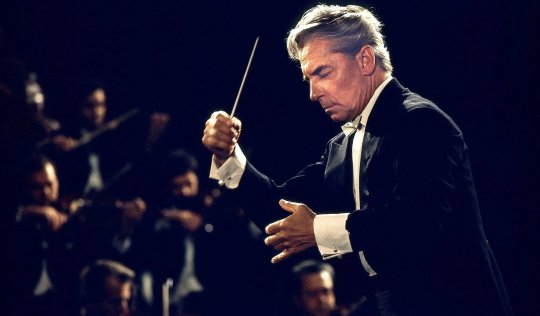
Driven by a fanatical love of music and a desire to advance his career, there’s little doubt that Karajan’s involvement with the Nazi regime was opportunistic.
Doubtless though there were also areas of Nazi policy that may well have chimed in with his own views. At the same time falling foul of the regime on occasions, his personal ideology can be best described as a montage of greys; nothing is ever clear-cut and nor perhaps should be our assessment of his work.
#karajan#herbert von karajan#quote#conductor#music#german#nazi germany#nazism#opera#orchestra#classical music#history#arts#culture
36 notes
·
View notes
Text

via Maren Knapp-Voith
Post von Wagner Benno
Geschichte ist, was nicht vergangen ist. Das Einzigartige an der Vergangenheit ist, dass sie nicht vergeht (Brock). Ein Freundin sendet mit heute morgen Fotos von ihrer Talfahrt durch Wuppertal. Das ist der Eingang des humanistischen Gymnasiums namens Wilhelm Dörpfeld. Darum griechische Letter am Sockel. Das sind Untertitel.
Aber stand da nicht einmal etwas, also auch auf dem Sockel und über den Untertiteln? Ja klar, eine Pallas Athene von Arno Breker. Die ist jetzt, jüngst entfernt, aber nicht weg. Das ist polaroides Distanzschaffen, das Bilder mal hierin, mal dahin stellt. Was nämlich nicht da ist, ist fort, also hier. Ist das gut so? Bingo-Inos Pathosformel dafür: Ja, aber umgekehrt würde ich sagen.
Das Denkmal steht immer, Untertitel verschwinden nie, Obertitel leicht. Das ist jetzt das Denkmal des nichtvergangenen Nichts. Das war es aber schon immer.
2 notes
·
View notes
Text
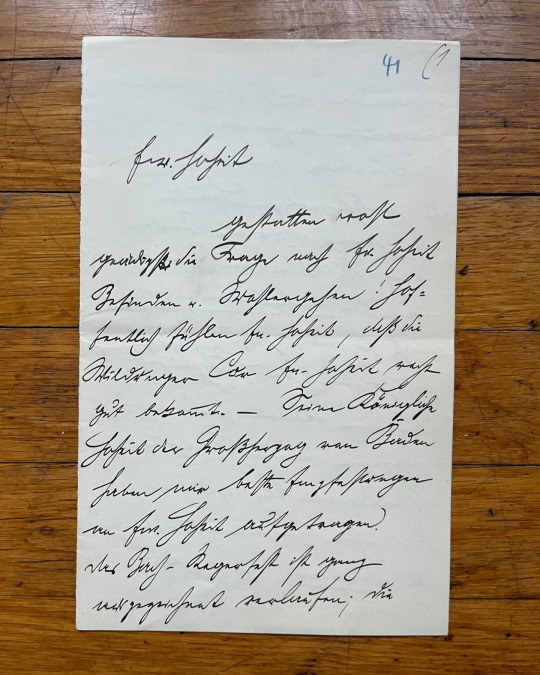


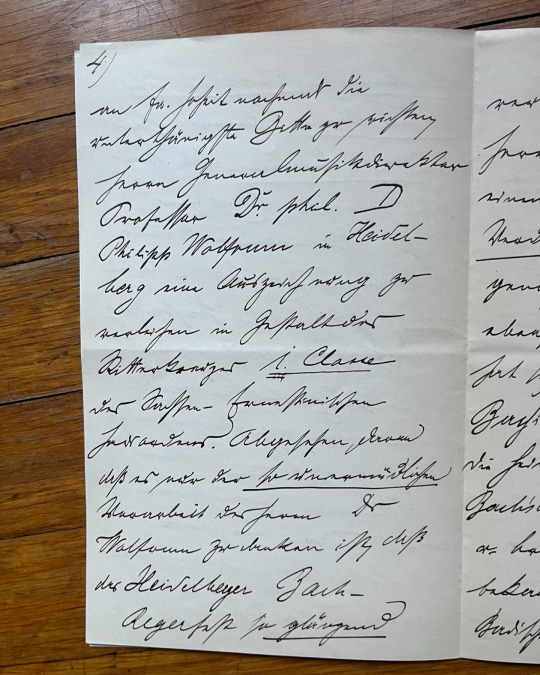


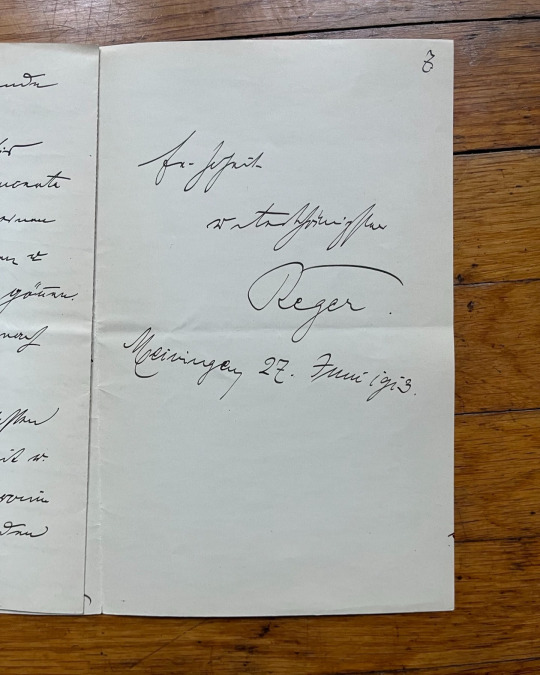

OTD in Music History: Composer, conductor, pianist, organist, and pedagogue Max Reger (1873 - 1916) was born 150 years ago in Bavaria.
As the central figure of the so-called "Back to Bach" movement that gained steam in the late 19th and early 20th Centuries, Reger represents a rather strange case: Many modern day "classical" music fans -- if they are familiar with him at all -- deride him as something of an aesthetic monster; the prototypically tasteless late-Romantic composer of swollen orchestral scores filled with long and pointless fugues on stylistically unsuitable subjects (like his gargantuan "Mozart Variations").
But Reger was actually a remarkably prolific composer, and a good deal of his original music -- which includes beautiful chamber works, charming piano miniatures, profound solo organ music, artful lieder, and daring unaccompanied violin sonatas -- is entirely devoid of the heavy-handed counterpoint which has given him a bad reputation in certain circles.
Arnold Schoenberg (1874 - 1951), for one, was extremely impressed by Reger the composer. Schoenberg summed up his thoughts in a 1922 letter that he sent to his friend and colleague, Alexander von Zemlinsky (1871 - 1942):
"Reger must, in my view, be played often: 1. because he has written a lot, and 2. because he is already dead and yet people are still not clear about him (I consider him to be a genius)."
One story about Reger has achieved a special scatological immortality within certain "classical" music circles:
Reger had a very acrimonious relationship with Rudolf Louis, a German music critic who absolutely despised his work. After Louis published a particularly scathing review of Reger's "Sinfonietta in A Major" (Op. 90), Reger responded with a curt letter which read as follows:
"Ich sitze in dem kleinsten Zimmer in meinem Hause. Ich habe Ihre Kritik vor mir. Im nächsten Augenblick wird sie hinter mir sein!" ("I am sitting in the smallest room of my house. I have your review before me. In a moment, it shall be behind me!").
What more is there to say?
PICTURED: A lengthy six page autograph letter that Reger wrote to a friend in 1913, discussing various musical matters.
Although in his own day he was often viewed with suspicion as one of the "dissonant ultramodernists" (a fact which is almost hard to believe now), as former New York Times Chief Music Critic Harold C. Schonberg (no relation to Arnold) explained:
"Reger himself thought of his music as a continuation of the German tradition. He also claimed that his music was written in the spirit of Bach and Beethoven. 'I can say with good conscience,' he wrote in 1914, 'that of all living composers, I am probably the one who is closest in touch with the great masters of our rich past.' The music of his own day, composed by epigones of Wagner and Strauss, he called 'perverted rubbish'… [and yet at the same time,] Reger himself felt an affinity to [Arnold] Schoenberg. Indeed, he once told the violinist Adolf Busch that of all of the then-modern composers, he felt closest Schoenberg. Likewise, scattered throughout Schoenberg's writings are references to Reger that make it clear that Schoenberg put him on as high a plane as Gustav Mahler and Richard Strauss…”
Perhaps it shouldn’t be surprising that a mutual fan club existed between Schoenberg and Reger -- after all, despite his own fearsome reputation as a "dissonant ultramodernist" (a reputation which, unlike Reger’s, persists to this day) Schoenberg also cut his compositional teeth working well within the lush Post-Romantic idiom (ex: "Verklarte Nachte")… and he too always proudly claimed an artistic lineage that extended straight back to Brahms, Beethoven, and Bach…
#Max Reger#Reger#Composer#classical composer#conductor#Conducting#pianist#piano#classical pianist#organist#classical music#organ#pedagogue#music teacher#teacher#music history#academic teacher#Violin Sonata#Sonata#Sechs Lieder#Zwölf Stücke#Gesang der Verklärten#Der 100. Psalm#Geistliche Gesänge#Die Nonnen#Piano Concerto#Die Weihe der Nacht#Eine romantische Suite#Variations and Fugue on a Theme by Mozart#Requiem
8 notes
·
View notes
Text
Tristan und Isolde in The Good Fight 6x04
i was not always an opera fan but i am always a fan of art referencing art. so when Tristan und Isolde popped up in season 6 of The Good Fight, you can imagine i was intrigued.
again, i wrote two threads on twitter, and i'm reposting here in lieu of there never being another thursday ep of TGF ever again (crying hours).

by Spanish artist Rogelio de Egusquiza's Tristan and Isolde (Death). 1910, oil on canvas, Bilbao Fine Arts Museum
anyways, T&I is an opera in 3 acts by Richard Wagner with a German libretto, based on a 12C romance Tristan and Iseult by Gottfried von Strassburg. known for tonal ambiguity, orchestral colour, harmonic suspension & chromaticism (very basically, using tones outside major/minor scales).
i will say from the outset i am not a Wagner fan (google it, but also it's rather ironic given what happens in this ep), but i have been to the villa where he lived in Lucerne (great views). (Walter Benjamin called Wagner an example of "bourgeois false consciousness" lolol)
anyway back to T&I… he wrote it while having an apparent affair with Mathilde Wesendonck 👀🍵 but it was also written after his discovery of Schopenhauer, a German philosopher who also influenced Tolstoy.
his point was to write tragedy, not romance, and his work marks the departure from tonal harmony in 20C EU classical music. the opening is called the Tristan chord—listen to the dissonance, nothing being resolved.
T&I uses harmonic suspension—creating musical tension and expectation in the listener through prolonged unfinished cadences. but he does so throughout the whole work, like introducing a cadence in the prelude and not resolving until Act 3 Finale.
and um, this deferred resolution is frequently interpreted as symbolising both physical sexual release and spiritual release (aka death ahah). there is also a day/night, life/death theme going on—opposites attract.
to return to Schopenhauer and the general storyline of T&I, it's really premised on the idea of unfulfilled longing and unachievable desires. make of that what you will.
[pre-finale addendum] i never really thought T&I was a direct metaphor, but more about how love doesn't always triumph. tragedy.
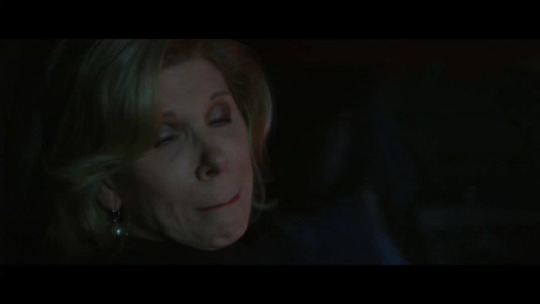
the important thing about the T&I plot is that it's a chivalric romance with certain elements, based on ancient Celtic myth, though the opera itself is based on a Medieval German retelling:
the brave hero (you're my hero)
the forbidden/doomed lovers (can your love survive outside the bubble)

and of course, the love potion, which makes Isolde fall in love with Tristan whom she had previously sworn hatred for after he killed her uncle. it SHOULDN'T make sense, and yet Diane and Kurt fall in love anyway.

the love potion is magic, but it is also poison (this is where it could become a metaphor* for PT108). and it doesn't just slowly poison them, eventually in the opera it poisons everything and leads to the lovers' downfall.

****(ftr, i do not think PT108 itself is poison & certainly not in reference to a depression treatment)
there are interesting doubles in T&I, mostly that Tristan's first wound is healed magically by Isolde, but later he's mortally wounded when Isolde doesn't reach him in time.

(Rogelio de Egusquiza, Tristan and Isolde (Life). 1910, oil on canvas, Bilbao Fine Arts Museum)
i think we see this flipped in TGF. in s1-2, Di has been wounded emotionally by Kurt and eventually they reconcile. but in s6, Di has been depressed and had multiple near death experiences, and yet Kurt doesn't seem to be able to reach her.

hence the quote: 'Here he lies, the great man, in thrall to the world’s most wonderful delusion—love.' and like the opera, the harmonies won't resolve until the very end.
[post-finale note] i did realise that when the Liebestod is playing while Diane and Kurt are talking on the sofa after the gala dinner that it does resolve. the answer was always there, that they would resolve together.
youtube
#tristan und isolde#richard wagner#the good fight#the good wife#diane lockhart#christine baranski#robert and michelle king#nat's tangents#the good universe#nat's art history threads#the art of referencing art in art
12 notes
·
View notes
Text









Kritiker zu Besuch pt. 2 oder Wie man Claus auf den Keks geht
| Die Anstalt vom Juni 2020
Besucher: "Kritische Stimmen kamen hier einfach nicht mehr zu Wort, egal wie unqualifiziert sie waren."
CvW: "Oh, ich glaube, Sie wollten sagen 'wie qualifiziert sie auch waren'."
Besucher: "Da, schon wieder! Abweichende Meinungen werden einfach mundtot gemacht!"
English translation and two more gifs below:
Critic on a visit or how to get on Claus' nerves | Die Anstalt from June 2020
visitor: "Critical voices were simply not getting a chance to speak here, no matter how unqualified they were."
CvW: "Oh, I think you wanted to say 'no matter how qualified they were'."
visitor: "There it is again! Dissenting opinions are simply silenced!"


CvW (after the visitor has been passing photo prints under the door): "Listen, it's my lunch break right now and we can - You don't have to film everything now, ok? Gosh, I can't believe it."
visitor (referring to the print): "Here, that's professor Ioannidis, right, from Standford University... in America..."
CvW: "Mh-hm..."
#the gifs nobody needs™️ have reached a new level of uselessness#charlie if you can see some sense in these lmk#there was a theme i swear xD#n said to post this nonsense nevertheless#i'm guilty of not giffing the destroyed whiteboard or max as coronavirus or scheuer in pink bathrobe or 'siri' in bill gates' head#max gets more brilliant the more ridiculous his roles are tbh#a fever dream of an episode#kritiker zu besuch#die anstalt#claus von wagner#max uthoff#my edit#my gif
10 notes
·
View notes
Video
vimeo
GOOGLE // Your Life with Pixel // LENNOX STORY from Stefanie Soho on Vimeo.
Lennox is heartbroken about the fight he had with his best friend, with whom he’s secretly in love. Instead of confessing his love, he pushed her away. Now he’s figuring out how to make it up.
This is the Director’s Cut.
______
Client: Google
Brand Marketing Manager: Alexa Rose
Head of Brand & Creative: Jakob Kriwat
Creative Strategy: Janosch Einck
Associate Product Marketing Manager: Mariya Kvitka
Agency: Anomaly Berlin
Managing Partner: Simon Owen
Managing Director: David Barton
Creative Director: Anna Nowok, Henrik Edelbring
Business Director: Amelie Schad
Project Manager: Kurt Mattich
Creative: Anna Broujean
Creative 2nd Unit: Greg Marangon
Copywriter: Fabiot von Falkenhayn
Senior Producer: Roy Ami
Production Assistant: Aliaa Salaheldin
Production: BWGTBLD GmbH
Managing Partner: Jakob Preischl
Kryptonite-Wrangler: Philipp Ramhofer
Producer: Rayk Hawlitschek, Greta Mueller
Production Coordinator: Johanna Katz
Team: Alex Göke, Leonor Alexandrino, Louise Wachtmeister, Theo Fleury, Prodromos Antoniadis
Production Manager: Steffen Gregorowius
Production Assistant: Sophia Repp
Set Manager: Marc Drobny
Director: Stefanie Soho
DOP: Christophe Colette
2nd Unit Director: Lukas Keuchel
2nd Unit DoP: Moritz Matlik
1st AD: Matthias Nerlich
Script Supervision: Jackie Jansen
2nd Unit AD: Imri Kahn
1st AC: Tom Zylla
2nd AC: Simon Wandelt
Key Grip: Olando Gübel
Gaffer: Albrecht Silberberger
DIT: Frank Hellwig
Sound Recordist: Manuel Vogt
Production Design: Tommy Stark
H&M: Nadin Wagner, Kieu Anh Duong
Styling: Julia Quante
Casting: Vollmar Casting
Cast: Lapo Hans Schleifer & Lillemore Leistenschneider
Post Producer: Johannes Böttge
Edit: Jacob Ipsen
Music: Alexis Troy
Sound Design & Mix: Moritz Staub
Color: Nicke Cantarelli
VFX: NHB Berlin
Online: Marvin Kühner
12 notes
·
View notes
Text
Ausgerechnet Wagner ... oder:
Leidensgenossen müssen nicht solidarisch sein.
3 notes
·
View notes
Text
A NIGHTMARE ON ELM STREET 3: DREAM WARRIORS (1987) – Episode 224 – Decades Of Horror 1980s
“Welcome to prime time, bitch!” Not words I’d use in front of my mother, but they are iconic just the same. Join your faithful Grue-Crew – Chad Hunt, Bill Mulligan, Crystal Cleveland, and Jeff Mohr, along with guest host Ralph Miller – as they enter another Wes Craven nightmare, A Nightmare on Elm Street 3: Dream Warriors (1987). Expect a lot of FX talk with Ralph in the house!
Decades of Horror 1980s
Episode 224 – A Nightmare on Elm Street 3: Dream Warriors (1987)
Join the Crew on the Gruesome Magazine YouTube channel!
Subscribe today! And click the alert to get notified of new content!
https://youtube.com/gruesomemagazine
A psychiatrist familiar with knife-wielding dream demon Freddy Krueger helps teens at a mental hospital battle the killer who is invading their dreams.
[NOTE: Effects crew credits are listed as they appear in the film credits.]
Director: Chuck Russell
Writers: Wes Craven (story) (screenplay) (characters); Bruce Wagner (story) (screenplay); Frank Darabont (screenplay); Chuck Russell (screenplay)
Music: Angelo Badalamenti
Storyboard Artist / Visual Consultant: Peter von Sholly
Stop-Motion Skeleton and Marionette Effects: Doug Beswick Productions, Inc.
Stop-Motion Animation: Doug Beswick
Effects Photography Supervisor: Jim Aupperle
Stop-Motion Puppet Construction: Yancy Calzada
Marionette Construction: Mark Bryan Wilson (as Mark Wilson)
Miniatures: James Belohovek
Illustrator: Larry Nikolai
Makeup effects Sequences: Greg Cannom
Assistants to Greg Cannom: Larry Odien, Earl Ellis, John Vulich, Keith Edmier, Brent Baker
Krueger Makeup effects: Kevin Yagher
Assistants to Kevin Yagher: Jim Kagel, Mitch DeVane, Gino Crognale, Brian Penikas, David Kindlon, Steve James, Everett Burrell
Makeup Effects Sequences: Mark Shostrom
Assistants to Mr. Shostrum: Robert Kurtzman, Bryant Tausek, John Blake Dutro, James McLoughlin (as Jim McLoughlin), Cathy Carpenter
Additional Makeup Effects: Matthew W. Mungle (as Mathew Mungel)
Assistant to Mathew Mungel: Russell Seifert
Mechanical Effects: Image Engineering
Special Effects Coordinator: Peter Chesney
Lead Technician: Lenny Dalrymple
Mechanical Designers: Bruce D. Hayes (as Bruce Hayes), Joe Starr, Anton Tremblay (as Tony Tremblay)
Effects Technicians: Bernardo F. Munoz (as Bernard Munoz), Rod Schumacher, Bob Ahmanson
Effects Crew: Scott Nesselrode, Tom Chesney, Kelly Mann, Phillip Hartmann (as Phillip Hartman), Ralph Miller III (as Ralph Miller), Joel Fletcher, Brian Mcfadden, Sandra Stewart (as Sandy Stewart), Terry Mack (as Troy Mack), Blaine Converse, Ron MacInnes, Brendan C. Quigley
Selected Cast:
Heather Langenkamp as Nancy Thompson
Craig Wasson as Dr. Neil Gordon
Patricia Arquette as Kristen Parker
Ken Sagoes as Roland Kincaid
Ira Heiden as Will Stanton
Rodney Eastman as Joey Crusel
Jennifer Rubin as Taryn White
Penelope Sudrow as Jennifer Caulfield
Bradley Gregg as Phillip Anderson
Laurence Fishburne as Max Daniels (credited as Larry Fishburne)
John Saxon as Donald Thompson
Priscilla Pointer as Dr. Elizabeth Simms
Clayton Landey as Lorenzo
Brooke Bundy as Elaine Parker
Nan Martin as Sister Mary Helena
Stacey Alden as Nurse Marcie
Dick Cavett as Himself
Zsa Zsa Gabor as Herself
Paul Kent as Dr. Carver
Guest host Ralph Miller III, who worked behind the scenes on Dream Warriors provides insights and many effects development photos that are shown in the YouTube version of the podcast. Post-recording, the crew wants to clarify that Kevin Yagher was responsible for the Freddy Snake, and Mark Shostrom was in charge of the Penelope Sudrow dummy that smashes into the Freddyvision TV.
With the success of A Nightmare on Elm Street 3: Dream Warriors (1987), following the critical failure of A Nightmare on Elm Street 2: Freddy’s Revenge (1985), New line Cinema firmly cemented Freddy Krueger and A Nightmare on Elm Street as one of the most iconic horror franchises of its time. Not only does Dream Warriors feature Robert Englund continuing to breathe both humor and fear into Freddy Krueger but also the return of both Heather Langenkamp and John Saxon from the original. The film also features Craig Wasson (Ghost Story) as the male lead and early film roles for Patricia Arquette and Larry Fishburne. Frank Darabont (The Mist) and Bruce Wagner join Wes Craven on scripting chores and Chuck Russell (The Blob, The Mask) directs while Angelo Badalamenti (Twin Peaks, Blue Velvet) provides the score – a winning combination of talent. Surely a Grue-Crew highly recommended selection with special effects by Greg Cannom, Doug Beswick, Mark Shostrom, Kevin Yagher, and more!
Be sure to check out the first time the 80s Grue-Crew took a dive into this film in February 2017, featuring Doc Rotten, Christopher G. Moore, and Thomas Mariani as the Grue-Crew. You can find it here: A NIGHTMARE ON ELMS STREET 3: DREAM WARRIORS (1987) — Episode 102
Every two weeks, Gruesome Magazine’s Decades of Horror 1980s podcast will cover another horror film from the 1980s. The next episode’s film, chosen by Jeff, will be The Changeling (1980), starring George C. Scott, Trish Van Devere, Melvyn Douglas, . . . and a bouncing, red, rubber ball.
Please let them know how they’re doing! They want to hear from you – the coolest, grooviest fans – so leave them a message or comment on the gruesome Magazine Youtube channel, on the website, or email the Decades of Horror 1980s podcast hosts at [email protected].
Check out this episode!
5 notes
·
View notes
Text
NXT Fake Rankings, 12/23/2022
Men's singles division - babyfaces
Bron Breakker (NXT men's champion)
Wes Lee (NXT North American champion)
Apollo Crews
Axiom
Odyssey Jones
Xyonn Quinn
Ikemen Jiro
Damon Kemp
Men's singles division - heels
Grayson Waller
Carmelo Hayes
Dijak
Joe Gacy
Von Wagner
JD McDonagh
Scrypts
Charlie Dempsey
Unranked: Dante Chen, Guru Raaj, Hank Walker, Javier Bernal
It's been sixteen months since WWE started dismantling Triple H's vision of NXT, and about five months since Vince McMahon retired and left Triple H in charge of creative. It's telling that almost no one on the roster during the Wednesday Night Wars is still here. I suspect Vince's "up or out" mentality is still in effect, and NXT won't see another long-term mainstay like Johnny Gargano or the Undisputed Era.
On the other hand, I think Solo Sikoa is the only NXT 2.0 performer who has been called up to the main roster. At that rate, it might take a few years to completely turn over the roster again. When Vince was in charge I would have expected Breakker, Jones, and Wagner to get called up by April 2023 whether they were ready or not. As it is, we'll have to wait and see how long Triple H wants everybody to spend in developmental.
Men's tag team division - babyfaces
Kofi Kingston & Xavier Woods (NXT men's tag team champions)
Josh Briggs & Brooks Jensen
Edris Enofe & Malik Blade
Brutus Creed & Julius Creed
Andre Chase & Duke Hudson
Men's tag team division - heels
Pretty Deadly - Elton Prince & Kit Wilson
Tony D'Angelo & Channing Lorenzo
The Dyad (Jagger Reid and Rip Fowler, formerly James Drake and Zack Gibson) and Indus Sher (Veer Mahan and Sanga, formerly Rinku and Saurav) are featured on TV but haven't wrestled in the past month. I'm surprised they haven't done anything with Gallus (Mark Coffey, Joe Coffey, and Wolfgang), who are apparently still employed but you'd never know it from watching the product.
Women's singles division - babyfaces
Roxanne Perez (NXT women's champion)
Alba Fyre
Wendy Choo
Indi Hartwell
Nikkita Lyons
Fallon Henley
Thea Hail
Women's singles division - heels
Cora Jade
Isla Dawn
Zoey Stark
Elektra Lopez
Kiana James
Unranked: Amari Miller, Lyra Valkyria, Sol Ruca
NXT shot itself in the foot by building the entire women's division around "Mandy Rose is super hot" for 400+ days, and then abruptly releasing her for being too super hot. Having her put over Perez is all well and good, but she could have spent the next year or so giving the rub to several other women.
If you don't want your talent posting nude photos on the internet, you need to pay them enough to make it worth their while. And if you don't want to pay them enough, it makes no sense to push them so strongly. So now Mandy's making a shitload of money and living her best life, and all I can say about NXT's women's roster is "Roxanne and a bunch of nobodies who couldn't beat Mandy."
Women's tag team division - babyfaces
Kayden Carter & Katana Chance (NXT women's tag team champions)
Ivy Nile & Tatum Paxley
Women's tag team division - heels
Toxic Attraction - Gigi Dolin & Jacy Jayne
NXT can still only scrape together three women's tag teams, which is still better than Raw and Smackdown put together, which is kind of sad.
No TV or PPV matches in over 30 days: Jagger Reid, Lash Legend, Oro Mensah, Rip Fowler, Trick Williams, Valentina Feroz
No TV, PPV, or streaming matches in over 30 days: Ava Raine, Boa, Cameron Grimes, Ilja Dragunov, Joe Coffey, Mark Coffey, Meiko Satomura, Nathan Frazer, Quincy Elliott, Roderick Strong, Sanga, Sarray, Tyler Bate, Veer Mahan, Wolfgang
Boa has been on the NXT roster since like 2017, and the only reason I know that is because I keep track of things like that for stuff like this. I don't want anybody to lose their job but I am genuinely perplexed how he survived all the releases over the past three years.
Not listed on NXT roster: Aleah James, Blair Davenport, Noam Dar, Stevie Turner
In August, WWE shut down NXT UK and released much of the roster. Everyone else got reassigned to Original Flavor NXT...except these four, for some reason. WWE.com still lists them as "current superstars" but not for any particular show. I can only guess that several of them are awaiting a rebranding like Aoife Valkyrie/Lyra Valkyria and Oliver Carter/Oro Mensah. But Davenport already has a WWE-owned name, and I haven't heard of her being injured, so I don't know what's up with her.
Inactive
Tiffany Stratton (head - unspecified injury)
Yulisa Leon (right knee - unspecified ligament tear)
I wouldn't be surprised if there are more people sidelined on the NXT roster, but reliable information has gotten harder to find as the brand has become less relevant.
4 notes
·
View notes
Text
Frankfurts Grüne wollen Straßen deutscher Geistesgrößen umbenennen – wegen “Antisemitismus”
Ansage: »Ohne Bevormundung und Verbote können Grüne nicht leben. Diese Veranlagung scheint geradezu eine Grundvoraussetzung für die Parteimitgliedschaft zu sein. Nun verlangt die Grüne Jugend in Frankfurt am Main, dass Straßen und Plätze, die den Namen von Martin Luther, Richard Wagner, Richard Strauss, Ernst-Moritz Arndt oder Theodor Fontane tragen, wegen deren Antisemitismus umbenannt werden. Deshalb platzierte sie […]
The post Frankfurts Grüne wollen Straßen deutscher Geistesgrößen umbenennen – wegen “Antisemitismus” first appeared on Ansage. http://dlvr.it/T3rWQt «
0 notes